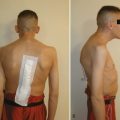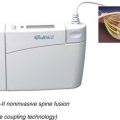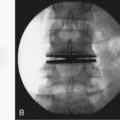CHAPTER 63 Nonoperative Management of Lumbar Spinal Stenosis
Lumbar spinal stenosis (LSS) is best defined as a clinical syndrome of buttock or lower extremity pain, with or without low back pain, resulting from diminished space for neurovascular elements in the spinal canal.1 A clinical definition is preferred because imaging findings do not correlate with symptoms. Approximately 20% of asymptomatic individuals older than age 60 years have stenosis on magnetic resonance imaging (MRI).2 Anterior-posterior spinal canal diameter is not predictive of symptoms or prognosis.3 Since its description as a distinct clinical entity in the early 1950s, LSS has been increasingly identified as a common clinical problem in older adults and now represents the most common diagnosis requiring spinal surgery in patients older than 65 years of age.4
Clinical Aspects
The classical symptom of LSS is pseudoclaudication—leg pain, paresthesias, and/or weakness provoked by walking or standing and relieved with forward flexion (i.e., sitting or squatting) noted in more than 90% of patients.5 Though axial lumbar pain may be present, most patients with LSS report greater lower extremity discomfort than spinal pain. Physical examination in patients with LSS may be unremarkable with a minority of patients demonstrating provocation of leg symptoms with spinal extension or an abnormal Romberg test. Findings such as diminished patellar or Achilles reflexes, focal muscle weakness, or positive nerve tension signs are noted in only a minority of patients.
Natural History of Lumbar Spinal Stenosis
Understanding the natural history of untreated spinal stenosis is crucial to making any recommendation for treatment, medical or surgical. Unfortunately, surprisingly little information about the course of untreated LSS is available. Johnson6 reported the course of 32 patients with myelographically confirmed stenosis and radicular or claudication pain followed for a mean of almost 4 years without any medical/interventional or surgical treatment. Pain as assessed by visual analog pain scores (VASs) was unchanged in 70% at final follow-up, improved in 15%, and worse in 15%, suggesting a benign course in most patients. Functionally, walking capacity at 4 years was unchanged from baseline. In these untreated patients, no severe or catastrophic neurologic deterioration occurred.
Several studies have compared surgical and nonsurgical treatment in patients with LSS, but none have included an untreated control group. As a result, unfortunately, they do not provide further insight into the natural history of untreated LSS. However, the results do suggest that approximately 50% of patients with mild to moderate LSS managed without surgery have a favorable course. Malmivaara7 reported a prospective randomized controlled trial comparing surgical treatment (undercutting laminectomy) with medical management (physical therapy) in 94 patients with symptomatic LSS severe enough to warrant treatment. Both groups demonstrated improvement at their 2-year follow-up. Clinically significant improvement in the Oswestry Disability Index (ODI) was noted in 55% of surgical patients and 42% of nonoperative patients. No difference in walking ability was detected. Weinstein reported a prospective randomized trial with an observational cohort comparing surgical and nonsurgical treatment in patients with LSS who were felt to be surgical candidates.8 Though surgical patients demonstrated superior improvement at 2 years, nonoperatively treated patients demonstrated improvements as well, in the ODI and bodily pain and physical function indices of the SF-36. The Maine lumbar spine study reported the results of a prospective cohort trial comparing medical and surgical treatment of 148 patients with LSS, some followed for up to 10 years.9,10 Patients were treated in community-based orthopedic and neurosurgery practices in Maine. Medical treatment was not specified by the study but most frequently included physical therapy (modalities and exercises), manipulation, analgesics, and epidural injections. After 4 years, 70% of the surgically treated patients and 52% of the medically treated patients reported improvement in their dominant symptom. After 8 to 10 years a similar percentage of surgical and medically treated patients available for evaluation reported improvement in their predominant symptom (54% vs. 42%). Both groups reported comparable satisfaction with their current status (55% and 49%). In a cohort of 68 patients with LSS with moderate symptoms who were treated medically, Amundsen reported about 70% of persons had good outcomes at 10 years.11 Medical treatment included a 1-month stay in a rehabilitation unit with bracing. Outcomes in conservatively managed patients who ultimately required surgery did not differ from patients who were selected for initial surgical treatment (i.e., delay in surgery did not adversely affect results).
Nonoperative Management
Whether medical/interventional treatments improve the outcome of patients with spinal stenosis in comparison with the generally favorable natural history of the disease remains uncertain. A recent systematic review of the literature found no direct comparisons of active treatment to an untreated control group.1 Medical treatment is therefore based primarily on clinical experience and training. In most patients a combination of physical therapy, medications, and spinal injections are considered with the objectives of relieving pain and functionally improving walking and standing time.
Drug Therapy
Though widely used, the efficacy of analgesics and nonsteroidal anti-inflammatory drugs (NSAIDs) has not been investigated in patients with lumbar stenosis. In the absence of studies demonstrating that NSAIDs are superior to simple analgesics, the risk of NSAID toxicity becomes the determining factor in therapeutic decision making. For osteoarthritis, on the basis of cost and toxicity associated with NSAIDs, the American College of Rheumatology (ACR) and the European League Against Rheumatism (EULAR) have both recommended acetaminophen as initial therapy.12 Doses of acetaminophen up to 4 g daily are typically well tolerated with an analgesic effect comparable with full-dose NSAIDs. Typically patients with LSS are older and more likely to suffer common comorbidities including hypertension, cardiovascular disease, and diabetes, which increase the risk of NSAID-induced cardiovascular, renal, and gastrointestinal toxicity.13–15 Extrapolating from these guidelines, pure analgesics including opioids would be the agents of first choice in patients with LSS. The fact that inflammation is not felt to play a central role in the pathogenesis of LSS lends further rationale for the choice of a pure analgesic in this high-risk population. However, even therapy with opioid analgesics often fails to produce significant functional improvement as assessed by increased walking or standing tolerance. The adverse effects of long-term opioid therapy including cognitive impairment and sedation are of particular concern in older stenosis patients at increased risk of falls.16
Gabapentin is an anticonvulsant and analgesic agent that has been found in multiple trials to be effective in the treatment of various neuropathic pain syndromes including diabetic neuropathy and postherpetic neuralgia.17 A recent trial found the addition of gabapentin to “standard treatment” including physical therapy and NSAIDs in patients with LSS resulted in significantly increased walking distance, as well as improved pain scores and recovery of sensory deficits.18 The promising results of this small pilot study need confirmation in a larger, placebo-controlled trial. Careful attention to common adverse effects of gabapentin, particularly sedation and dizziness, is crucial in treating patients with LSS. Other drugs used to treat neuropathic pain syndromes including pregabalin, tricyclic antidepressants, and duloxetine have not been studied in LSS. Because of potential cardiovascular toxicity, tricyclics should be used with caution in this population.
Calcitonin is a polypeptide hormone secreted by the parafollicular cells of the thyroid, which have been reported to have both analgesic and anti-inflammatory properties. Intramuscular and subcutaneous administration of the drug has been reported to improve walking distance and pain in some patients with LSS in older, smaller trials.19–21 More recently, two studies found no significant benefit of nasally administered calcitonin compared with placebo in patients with well characterized LSS in either pain or Oswestry Disability Index measures.22,23 The reasons for the differences in outcomes are unclear but may relate to differing bioavailability of the calcitonin related to the route of administration. Further investigation of intramuscular or subcutaneous calcitonin in LSS in a larger long-term controlled trial with updated stenosis-specific outcome measures seems warranted.
Physical Therapy
Though a recent systematic review of the literature found insufficient evidence to draw conclusions about the effectiveness of physical therapy or exercises as stand-alone treatments for lumbar spinal stenosis, therapeutic exercises have traditionally been incorporated in the nonoperative management of LSS.1 Traditional empirically based exercise programs in patients with stenosis have focused on the goals of decreasing lumbar lordosis and extension forces on the spine while improving abdominal “core” strength. Commonly, flexion-based lumbar stabilization exercises are recommended. This approach should include identification and treatment of hip flexion contractures, which may result in increased lumbar lordosis. Many patients with LSS are deconditioned as a result of symptom-limited walking and age-related comorbidities. Options for low-impact, aerobic training include stationary cycling, elliptical trainers, or aquatic exercise programs. Recent trials comparing structured physical therapy approaches in younger (mean age 58 years) LSS patients demonstrated comparable improvement in walking tolerance, pain, and Oswestry Disability Index scores with body weight–supported treadmill walking and cycling as the cardiovascular/aerobic component of a therapy program.24,25 Other potential benefits of active aerobic exercise include improvement in depression, assistance with weight control, and opportunities for increased socialization (group exercise programs). Physical therapy programs must be tailored to individual circumstances to optimize compliance, particularly in older, frailer elderly patients.
Passive modalities such as bracing or corsets, manipulation, transcutaneous electrical nerve stimulation (TENS), and acupuncture have not been sufficiently evaluated in patients with LSS. A lightweight lumbar corset that maintains a slight degree of lumbar flexion may offer some patients modest benefit. Prateepavanich26 noted improved treadmill walking distance and decreased pain in 21 patients with neurogenic claudication who were provided a lumbosacral corset.
Epidural Corticosteroid Injection
Epidural steroid injection (ESI) for spinal stenosis is directed at treatment of the presumed inflammatory reaction and edema present at the stenotic segment. Fluoroscopic guidance is strongly recommended for caudal, interlaminar, or transformational injection to ensure accurate needle placement. Renfrew27 demonstrated that nonfluoroscopically assisted injections were actually in the epidural space in only 62% of procedures performed by experienced physicians.
Ng and colleagues28 found no difference in pain or walking distance at 12-week follow-up between patients with LSS who received a single transforaminal, fluoroscopically guided ESI. However, several case series using a multiple injection regimen in patients with LSS have demonstrated that from one to two thirds of patients may experience long-term improvement extending to almost 2 years. In a multiple injection protocol, after an initial injection, an additional injection is performed only when severe symptoms recur. Botwin and colleagues29 reported a prospective series of 34 patients with LSS treated with a multiple-injection protocol of transforaminal lumbar epidural steroid injections and followed for 12 months. Seventy-five percent of patients had at least a 50% improvement in pain scores, and 64% noted improvement in walking tolerance.29 The average number of injections per patient was 1.9. Hoogmartens and colleagues30 reported that 32% of patients with severe pseudoclaudication defined by a walking distance of less than 100 m treated with multiple caudal injections reported good to excellent improvement in symptoms at an average follow-up of 23 months. In a more recent retrospective study of 140 patients with LSS treated with either fluoroscopically guided transforaminal or caudal ESI, Delport and colleagues reported 32% of patients experienced pain relief at their 2-month follow-up after an average of 2.23 injections.31 Fifty-three percent reported improvement in their functional abilities.
Before an epidural injection, anticoagulants and antiplatelet agents including NSAIDs and clopidogrel are usually discontinued for approximately 1 week. Unfortunately, in anticoagulated patients with severe comorbid cardiovascular disease with LSS who are not surgical candidates, this may be contraindicated, eliminating this nonoperative option. A relatively common adverse effect, transient headache, is seen in up to one quarter of patients treated with epidural steroids.32 More serious complications including epidural abscess, meningitis, and spinal hematomas are rare.33
Lumbar Spinal Stenosis: Evidence-Informed Approach to Management
Pearls
Key Points
1 Watters WC, Baisden J, Gilbert TJ, et al. Degenerative lumbar spinal stenosis: an evidence-based clinical guideline for the diagnosis and treatment of degenerative lumbar spinal stenosis. The Spine Journal. 2008;8:305-310.
2 Katz JN, Harris MB. Lumbar spinal stenosis. N Engl J Med. 2008;358:818-825.
An excellent clinical overview addressing current diagnosis, medical, and surgical treatment.
3 Weinstein JN, Tosteson TD, Lurie JD, et al. Surgical versus nonsurgical therapy for lumbar spinal stenosis. N Engl J Med. 2008;358:794-810.
4 Yaksi A, Ozgonenel B. The efficacy of gabapentin therapy in patients with lumbar canal stenosis. Spine. 2007;32:939-942.
Rare study demonstrating efficacy of a pharmacologic therapy in patients with LSS.
5 Botwin KP, Gruber RD, Bouchlas CG, et al. Fluoroscopically guided lumbar transforaminal epidural steroid injections in degenerative lumbar stenosis. An outcome study. Am J Phys Med Rehabil. 2002;81:898-905.
1 Watters WC, Baisden J, Gilbert TJ, et al. Degenerative lumbar spinal stenosis: an evidence-based clinical guideline for the diagnosis and treatment of degenerative spinal stenosis. Spine J. 2008;8:305-310.
2 Boden SD, Davis DO, Dina TS, et al. Abnormal magnetic-resonance scans of the lumbar spine in asymptomatic subjects. A prospective investigation. JBJS. 1990;72A:403-408.
3 Geisser ME, Haig AJ, Tong HC, et al. Spinal canal size and clinical symptoms among persons diagnosed with lumbar spinal stenosis. Clin J Pain. 2007;23:780-785.
4 Chad DA. Lumbar spinal stenosis. Neurol Clin. 2007;25:407-418.
5 Katz JN, Dalgas M, Stucki G, et al. Degenerative lumbar spinal stenosis: diagnostic value of the history and physical examination. Arthritis Rheum. 1995;38:1236-1241.
6 Johnson EK, Rosen I, Uden A. The natural course of lumbar spinal stenosis. Clin Orthop Relat Res. 1992;279:82-86.
7 Malmivaara A, Slatis P, Heliovaara M, et al. Surgical or nonoperative treatment for lumbar spinal stenosis? A randomized controlled trial. Spine. 2007;32:1-8.
8 Weinstein JN, Tosteson TD, Lurie JD, et al. Surgical versus nonsurgical therapy for lumbar spinal stenosis. N Engl J Med. 2008;358:794-810.
9 Atlas SJ, Keller RB, WU YA, et al. Long-term outcomes of surgical and nonsurgical management of lumbar spinal stenosis: 8 to 10 year results from the Maine Lumbar Spine Study. Spine. 2005;30:936-943.
10 Atlas SJ, Keller RB, Robson D, et al. Surgical and nonsurgical management of lumbar spinal stenosis. Four-year outcomes from the Maine Lumbar Spine Study. Spine. 2000;25:556-562.
11 Amundsen T, Weber H, Nordal HJ, et al. Lumbar spinal stenosis: conservative or surgical management? A prospective 10 year study. Spine. 2000;25:1424-1436.
12 American College of Rheumatology Ad Hoc Group on the Use of Selective and Nonselective Nonsteroidal Antiinflammatory Drugs. Recommendations for use of selective and nonselective nonsteroidal antiinflammatory drugs: an American College of Rheumatology White Paper. Arthritis and Rheumatism (Arthritis Care and Research). 2008;59:1058-1073.
13 Gutthann SP, Garcia Rodriguez LA, Railford DS. Individual nonsteroidal anti-inflammatory drugs and other risk factors for upper gastrointestinal bleeding and perforation. Epidemiology. 1997;8:18-24.
14 Griffin MR, Yared RA, Ray WA. Nonsteroidal anti-inflammatory drugs and acute renal failure in elderly persons. Amer J Epidemiol. 2000;151:488-496.
15 Bennett JS, Daugherty A, Herrington D, et al. The use of nonsteroidal anti-inflammatory drugs (NSAIDs) A science advisory from the American Heart Association. Circulation. 2005;111:1713-1716.
16 Schofferman J, Mazanec D. Evidence-informed management of chronic low back pain with opioid analgesics. The Spine Journal. 2008;8:185-194.
17 Wong MC, Chung JW, Wong TK. Effects of treatments for symptoms of painful diabetic neuropathy: systematic review. BMJ. 2007;335:87.
18 Yaksi A, Ozgonenel L, Ozgonenel B. The efficacy of gabapentin therapy in patients with lumbar canal stenosis. Spine. 2007;32:939-942.
19 Eskola A, Alaranta H, Pohjolainen T, et al. Callcitonin treatment in lumbar spinal stenosis: clinical observations. Calcif Tissue Int. 1989;45:372-374.
20 Eskola A, Pohjolainen T, Alaranta H, et al. Calcitonin treatment in lumbar spinal stenosis: a randomized, placebo controlled, double-blind, crossover study with one-year follow up. Calcif Tissue Int. 1992;50:400-403.
21 Porter RW, Miller CG. Neurogenic claudication and root claudicateion treated with calcitonin: a double-blind trial. Spine. 1988;13:1061-1064.
22 Podichetty VK, Segal AM, Lieber M, Mazanec DJ. Effectivelness of salmon calcitonin nasal spray in the treatment of lumbar canal stenosis. A double-blind, randomized, placebo-controlled, parallel group trial. Spine. 2004;29:2343-2349.
23 Tafazal SI, Ng L, Sell P. Randomized placebo-controlled trial on the effectiveness of nasal salmon calcitonin in the treatment of lumbar spinal stenosis. Eur Spine J. 2007;16:207-212.
24 Whitman JM, Flynn TW, Childs JD, et al. A comparison between two physical therapy treatment programs for patients with lumbar spinal stenosis. A randomized clinical trial. Spine. 2006;31:2541-2549.
25 Pua Y, Cong-Cong C, Kian-Chong L. Treadmill walking with body weight support is no more effective than cycling when added to an exercise program for lumbar spinal stenosis: a randomized controlled trial. Australian J of Physiotherapy. 2007;53:83-89.
26 Prateepanvanich P, Thanapipatsiri S, Santisatisakul P, et al. The effectiveness of lumbosacral corset in symptomatic degenerative lumbar spinal stenosis. J Med Assoc Thai. 2001;84:572-576.
27 Renfrew DL, Moore TE, Kathol MH, et al. Correct placement of epidural steroid injections: fluoroscopic guidance and contrast administration. AJNR Am J Neuroradiol. 1991;12:1003-1007.
28 Ng L, Chaudhary N, Sell P. The efficacy of corticosteroids in periradicular infiltration for chronic radicular pain: a randomized, double-blind, controlled trial. Spine. 2005;30:857-862.
29 Botwin KP, Gruber RD, Bouchlas CG, et al. Fluoroscopically guided lumbar transforaminal epidural steroid injections in degenerative lumbar stenosis. An outcome study. Am J Phys Med Rehabil. 2002;81:898-905.
30 Hoogmartens M, Morelle P. Epidural injection in the treatment of spinal stenosis. Acta Orthop Belg. 1987;53:409-411.
31 Delport EG, Cucuzzella AR, Marley JK, et al. Treatment of lumbar spinal stenosis with epidural steroid injections: a retrospective outcome study. Arch Phys Med Rehabil. 2004;85:479-484.
32 Carette S, Leclaire R, Marcoux S, et al. Epidural corticosteroid injections for sciatica due to herniated nucleus pulposus. N Engl J Med. 1997;336:1634-1640.
33 Armon C, Argoff CE, Samuels J, Backonja MM. Assessment: Use of epidural steroid injections to treat radicular lumbosacral pain. Neurology. 2007;68:723-729.







